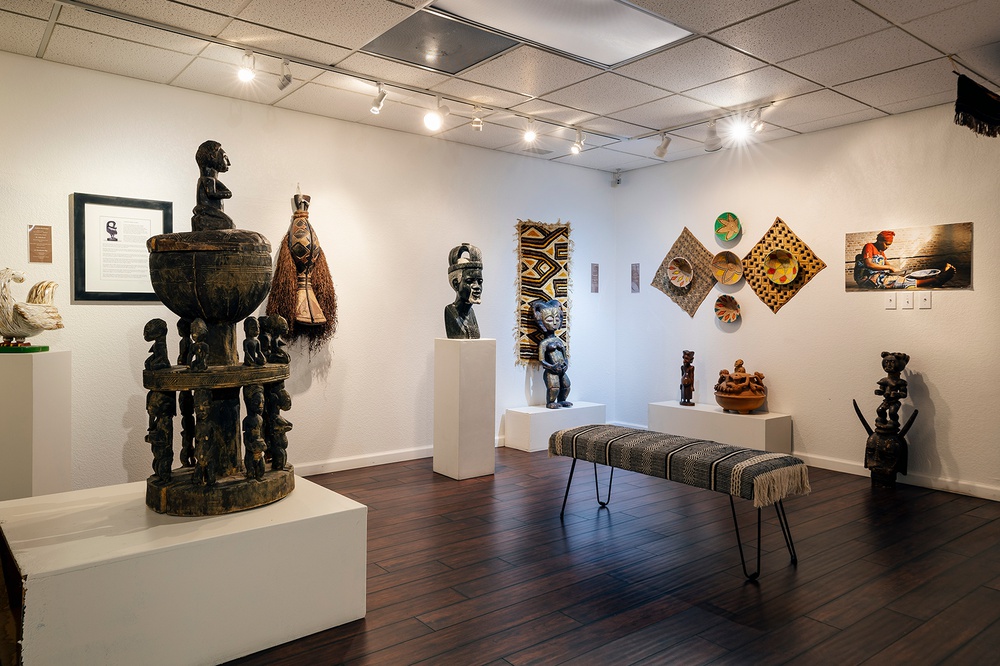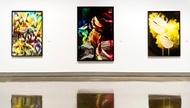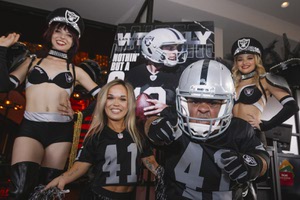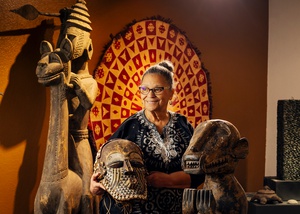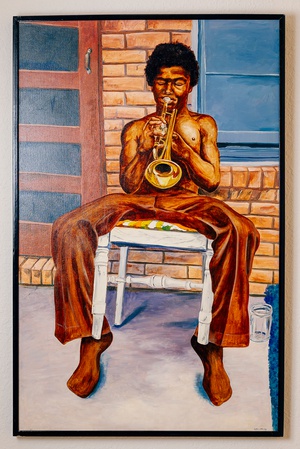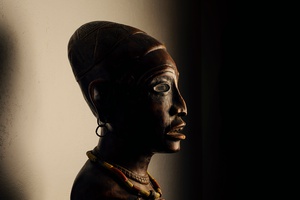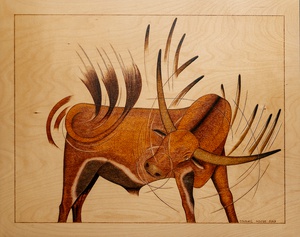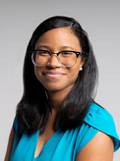“What is your gallery?”
It’s a question Vicki Richardson, artist and founder of Left of Center Gallery, gets asked a lot. But after some 30 years since the North Las Vegas gallery and nonprofit first opened, a better question might be, what isn’t it?
To many Black and brown artists in the Las Vegas community, it’s been a stepping stone to greater opportunities. To other creatives, who’ve thrived in the arts elsewhere, it’s a home base. To art students, it’s an institute of knowledge, a space where they can expand upon and give chase to their creative whims. To the general public, it’s something of a revelation.
Tucked away in a quiet residential neighborhood on West Gowan Road, Left of Center Gallery may as well be on its own island. It’s easy to miss and not much to look at from the outside, but at the threshold another world awaits. Several, actually.
The works of local art mavens like Justin Favela, Nancy Good, Jerry Misko, Chase R. McCurdy, Lance L. Smith and Mikayla Whitmore have all cycled through Left of Center, anointing the gallery with a spectrum of cultural experiences. Social justice exhibits, such as 2021’s Bending the Arc, have also challenged societal norms, inspired reflection and demanded we change. Meanwhile, a collection of rarified African art—sculptures, masks, tapestries and more—adorns the gallery’s second floor, shaping it into a heritage-rich gala of artifacts, many of which were donated from Richardson’s own personal collection.
“It’s one of those rare sites in the Valley that can transport you pretty much anywhere. I think it rivals pretty much any large museum institution anywhere I’ve been because of that careful selection and just stewardship of BIPOC vision,” says Erica Vital-Lazare, a local literary artist and College of Southern Nevada professor who sits on Left of Center Gallery’s board of directors.
“I can’t even express the level of abstract imagery that’s come through there. Figurative imagery that reflects Black and brown life, of course, but then these abstract artists give me a sense of the otherworldly. Vicki’s not a traditionalist in that sense that you might equate with a gallery that’s been around for more than 20 years.”
Open since the late 1980s, Left of Center Gallery became a nonprofit organization in 1997 and has remained a communal institution of North Las Vegas ever since.
“There’s no other place that I would rather be if I were living in Las Vegas, other than on the fringes like we have been,” says the 79-year-old Richardson, who moved to the Valley more than 30 years ago. “I’ve always been unafraid to extend myself for something that I felt was valuable, something that I thought was helping other people.”
That moral stance dates back decades for Richardson, who attended Fisk University in Nashville, Tennessee, a historically Black liberal arts college known for its sit-in demonstrations, which Dr. Martin Luther King Jr. once called, “the best organized and most disciplined in the southland,” during the civil rights movement.
Art played a role in that activism, and Richardson got firsthand experience with it. Aaron Douglas, one of the most influential artists of the Harlem Renaissance and a member of the Fisk faculty, left a lasting impression on her, a religion and philosophy major at the time.
“I had a lot of admiration ... He was just fascinating and encouraging,” she says. “When he was looking over my paperwork, I had illustrations in there, and he said, ‘You should be over here.’ So I said ‘Maybe I should.’ That’s what got me from religion and philosophy into art.”
Freedom, she says, resided in the art classrooms of Fisk. And as racial and political unrest ran rampant, art began to take on new power and meaning for Richardson.
“It’s more than just being able to paint a pretty flower, to get the technique,” she says. “It also gives you an avenue to change people’s minds, to grow yourself, to get your ideas on that paper and across to people, to challenge people when they look at your art.”
Richardson would go on to instill those teachings at inner-city schools in troubled areas of the South Side, where she taught art while getting her master’s degree at the University of Chicago.
At the time, she was a member of an experimental group of educators, sent in to create a multidisciplinary curriculum approach for schools being racially integrated. Richardson specifically asked to teach at the more racially diverse schools, and she would choose to invest in another when she moved to Las Vegas in 1979 to teach at Rancho High School.
“I had a lot of people telling me ‘No, you don’t want to go to Rancho. I said ‘Yes, I do,’” Richardson laughs. “When I went there, they were taking bets on how long I would last because the last two art teachers there hadn’t stayed more than six months.”
Instead of a regular classroom, she was issued a room that used to hold football equipment.
“It was a storage room. No intercom, and that was before cell phones, so you didn’t really have any way to communicate with the rest of the school. It was an isolated area, but it proved to be absolutely the best area,” she reasons. “With the climate here, we worked outside a lot. Nobody messed with me. They left me alone out there. And those kids, they were so happy they had a safe place to be creative and express themselves. It was wonderful.”
That emphasis on the underserved, on
the unseen and the unregarded is precisely what’s helped Left of Center Gallery stand out and endure.
As a Black artist who grew up in the projects of Hampton, Virginia, Vital-Lazare considers spaces like Left of Center essential to the growing generations.
“Our world seemed to be circumscribed by going across the street to the corner store. The acreages of the projects itself, the playground and school. That was the scope of your world,” she remembers.
“But one thing my mother had always done was take me to the museum, take me to the library, enroll me in arts programs, so that I knew … not that there wasn’t beauty where we were ... [but] that I got a case of other dimensions of beauty, other perspectives. And to also link you to other places aspirationally and geographically,” Vital-Lazare continues. “Art does that. Public art gives the viewer, particularly young viewers, space to dream. Space to imagine themselves as the artists.”
The creative writing professor recalls exploring art shows in the early days of coming here, only to find that they were “so heavily infused with this western aesthetic. I felt the scope of my experience was not welcome within those frames.”
Stumbling upon Richardson’s artwork, along with other Black artists at a small exhibit at the Charleston Heights Arts Center, came as a revelation.
“I was like, ‘Wait. There’s Black art here. That means there are Black people here. There’s an appreciation for the community here.’ And through that introduction I discovered the gallery community in North Las Vegas and West Las Vegas.”
Richardson also immersed herself in that community through a friendship she forged with Benny Cassel, a Las Vegas artist who owned an all-in-one gallery, classroom and bookstore on Martin Luther King and Lake Mead boulevards. That intersection of art and education would eventually become the bedrock of Left of Center Gallery.
“He was very, very dedicated to improving the lives of the people in our neighborhood. He was a real inspiration to me,” she says. “When he left to go to Africa for several years, because his wife was training teachers there, he left the gallery in my hands.”
In 1983, Richardson opened her own exhibition space and started asking to exhibit work in private galleries. But the initial reception wasn’t exactly favorable. Rejection was common, she says, as was feedback that the artwork was “too ethnic” to be sold. Eventually, it found a home in a Flamingo Library juried show.
“At first, we didn’t get in there either. But over a period of time, they started respecting what we were doing. It’s the quality of the work and the sincerity of the work that finally got us into some of these different art competitions,” she says. “But then we said, why are we breaking our necks? We’re trying to make a statement to them that our work is worthwhile, and that’s not necessarily the way to go. I said, we’re going to do our own thing. We’re going to start our own gallery.”
Richardson’s late husband Louis, an engineer and contractor who had helped build other schools, parks and fire stations in the Valley, established Left of Center Gallery on the once barren and secluded West Gowan Road. And in 1987, local artists Sylvester Collier and Harold Bradford became her co-founders.
“We could see nothing but desert out of our front window and a couple of riders because it used to be a horse country,” Richardson remembers. “We met some actual Black cowboys, and we would paint them and use them as subject matter, and they loved it.”
So, they had built it. But would people come?
“We had to look for our artists. We had to ask around the community. We had to go and visit them. We had to convince them, in some cases,” she says. “People had art that they had done when they were in college, and it was hidden in their garage or under their bed. We were on a mission to find artists that we knew existed in this community, but had stopped doing it.”
Richardson set out to make a Black gallery that would celebrate her culture. But never at the expense of anyone else. “Just because somebody did it to me, I’m not going to be exclusionary in what I put in the gallery,” she says. “I want good art.”
That ceaseless, inclusive pursuit has brought a vast pool of artists into Left of Center Gallery over the years, creating milestones for many of them.
A UNLV undergrad at the time, Las Vegas artist and teacher Lance L. Smith vividly remembers their 2011 exhibit at Left of Center feeling like their first “legit art show.”
“I’m grateful for that space for being so open,” says Smith, who has since shown work across the Valley and been awarded multiple artist residencies. “We think of artists like Chase R. McCurdy and a whole bunch of other artists who are coming up, we were all given the chance to walk through the threshold of a professional gallery. Those lines on your CV, they mean so much.”
“It’s always been a space that I hold dear,” Smith says. “I think of it as a space of jubilation, learning, exploration. It encapsulates so many facets for me.”
Since that first show, Smith has started teaching aspiring artists how to draw at Left of Center Gallery and plans to continue in the new year.
“Oftentimes gallery spaces, they get in a rut. They kind of only want to do certain things, and I think with the programming being run by Miss Vicki ... you’re seeing such variation,” Smith says. “They have life drawing classes, painting classes, exhibitions, they have town halls. It really is kind of a space where it’s a nexus. If you can get in there and really just show up, there’s so much that can be found.”
Smith stresses that the desire to champion and support the women at the helm of Left of Center Gallery is a priority. Because “this is not just for us folks who are living right now. There are future generations of artists that need this space.”
Meaningful, must-see works on display now at Left of Center
“A society without culture will have a hard time thriving.”
That statement, by Senegalese artist Djibril N’Doye, looms over Left of Center Gallery’s art space, where his latest show, Preservation of Life, Art and Culture, now sits on display.
The exhibit tactfully pays tribute to the Dogon people of Mali, whose culture is currently crumbling under the boot of religious extremism.Historic wood carvings and sculptures created by this indigenous West African group disappear by the day—destroyed, vandalized, discarded.
But artists like N’Doye refuse to forget them. Instead, he’s chosen to preserve them here at Left of Center Gallery.
The works on display may as well be a window into the West African world. N’Doye adorns his woodburned works in showers of color. Women in braids and fringed shawls face burnished copper sunsets; another weaves a prismatic patchwork of fabric across her knees on a frame of wooded birch panel; one group of masked drummers appear in a blur of shapes, giving the illusion of movement, of urgency in their playing.
More slices of beautiful Black life wrap around the gallery space, where N’Doye has meticulously dotted drawings out of ballpoint pen. “Young Girl Thinking,” an abstract portrait of a woman wearing cherry red earrings and a textured, almost three-dimensional patch of vest-like fabric, is a stunning example of N’Doye’s painstaking, ballpoint pen process. Her natural hair pitches forward, defying any sense of gravity.
On the upper floor of Left of Center Gallery, more African life has been preserved in the form of a large museum of artifacts. Western African instruments such as the “thumb piano” and the hourglass-shaped Fontomfrom drum—used to “communicate royal messages in Ashanti tribal settings”—can be marveled at here, alongside Congolese harps made of wood, hide and twin, horned ritual masks and peculiar spiked statues like the Nkisi Nkondi, which Kongo people used to hammer nails into to summon the ancestral spirit inside.
These works, and many others, defined Left of Center Gallery as a place of not just preservation but of celebration.
Click HERE to subscribe for free to the Weekly Fix, the digital edition of Las Vegas Weekly! Stay up to date with the latest on Las Vegas concerts, shows, restaurants, bars and more, sent directly to your inbox!
